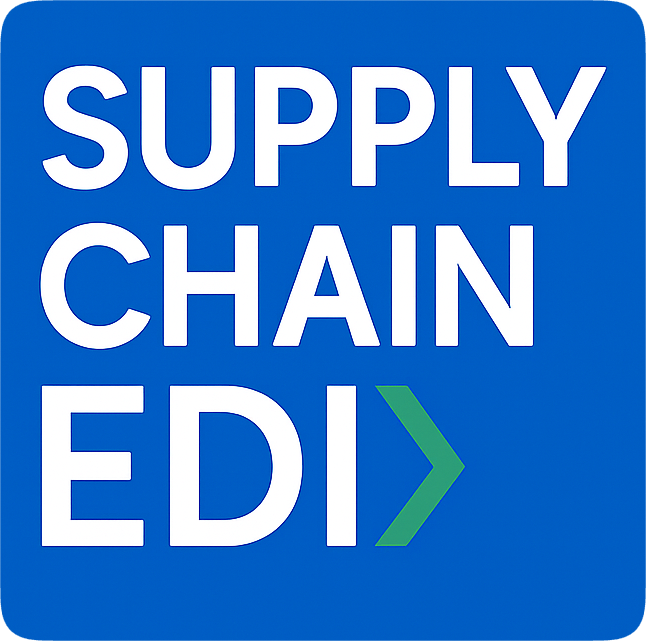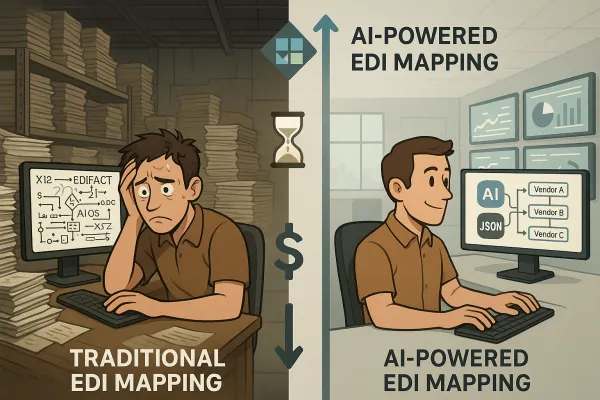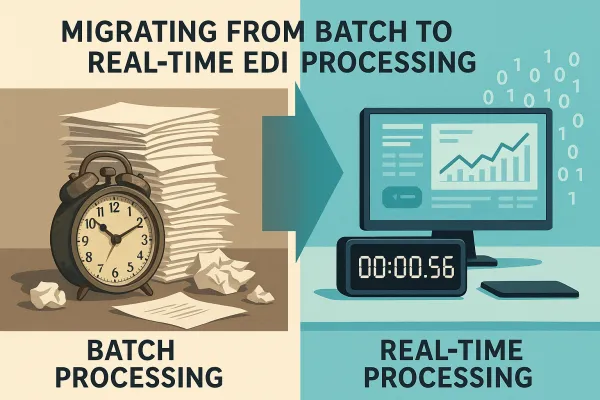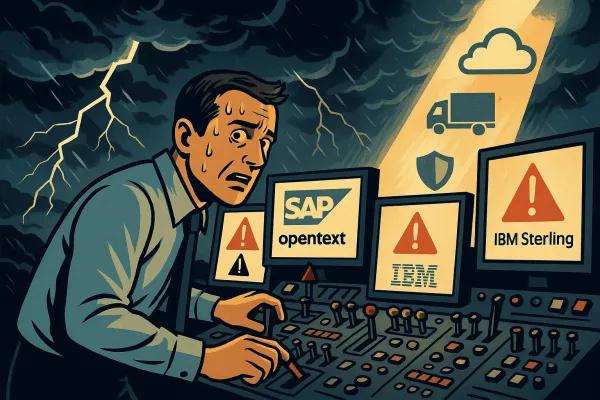The Strategic EDI Managed Services Decision Framework: How to Solve the Skills Crisis While Maintaining Control of Your Supply Chain Integration in 2025
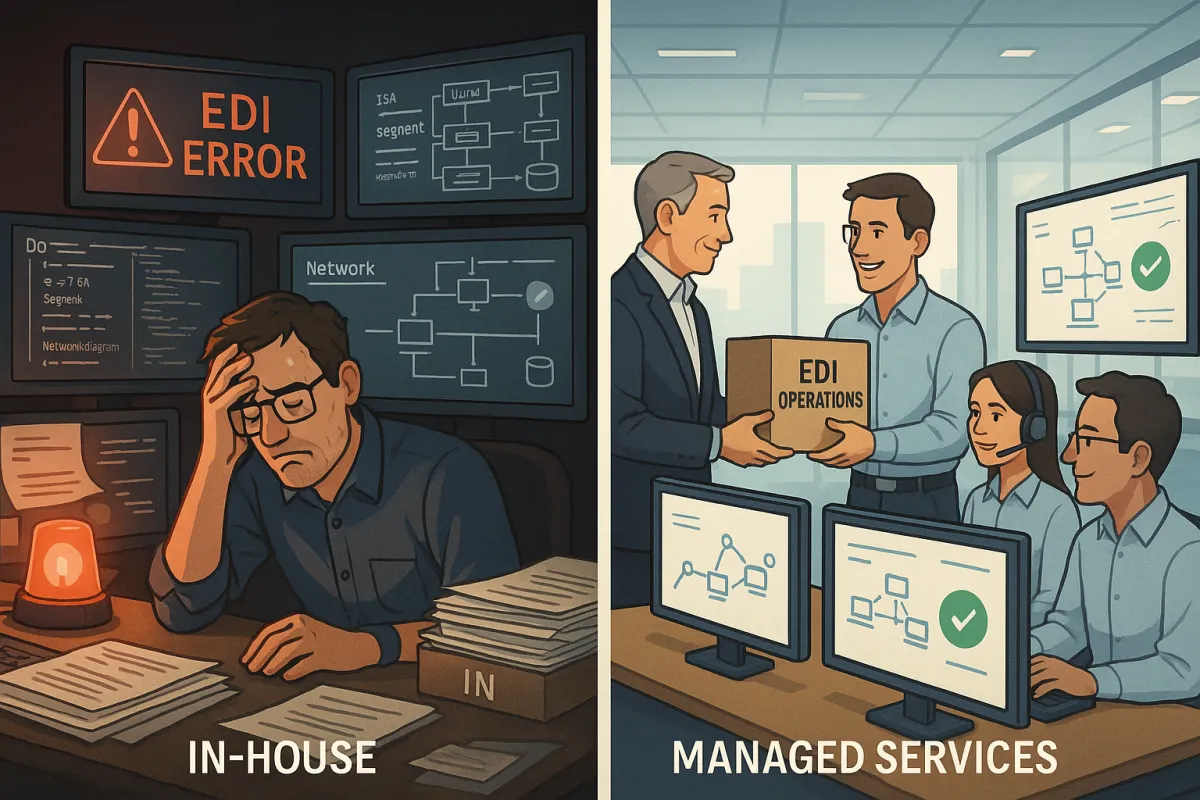
The EDI skills shortage has reached crisis proportions. 74% of employers say they are struggling to find the skilled talent they need, and the situation becomes even more acute when you look at specialized technology skills. EDI professionals are in high demand but there is a limited supply, creating a perfect storm for supply chain managers who need to maintain critical B2B integrations while their experienced team members approach retirement age.
You know the symptoms. Purchase orders stuck in processing limbo. Supplier onboarding projects dragging for months. This can be a time-consuming and intricate role as the employee is responsible for onboarding new trading partners, creating new connections, building maps, tracking orders, monitoring for issues and discrepancies, performing error resolution, and more. That also means a company has to find a skilled employee that can perform the job, as well as pay them for their services.
The economics are brutal. Smaller businesses may not be able to afford to pay a full-time employee to handle all their EDI tasks. For larger organizations, managing a large EDI ecosystem can quickly become complex and overwhelming for internal teams. That's driving a fundamental shift toward EDI managed services as organizations realize they can't build sustainable EDI programs around increasingly scarce technical talent.
The EDI Skills Crisis That's Forcing Strategic Decisions
The numbers paint a stark picture of what you're up against. The large majority of companies worldwide (87%) are aware that they either already have a skills gap or will have one within a few years, according to McKinsey research. For EDI specifically, When it comes to specialized technologies like EDI, skilled talent can be even harder to find. EDI solutions are a unique beast. Just like cybersecurity, they require dedicated expertise—and the best EDI providers come with a strong background in both EDI and cybersecurity.
What makes the EDI skills shortage particularly challenging isn't just the technical depth required. As more and more enterprises look to find new ways to modernize their environment and evolve to best meet the needs of their digital ecosystems, one of the hardest parts is finding adequate staff that are properly trained. However, the need for good talent within an IT department is as high as it's ever been. Staffing on-premise resources is often competitive as well as quite expensive.
Your EDI professional needs to understand EDIFACT standards, X12 message structures, VAN connectivity, mapping software, partner-specific requirements, error handling protocols, and increasingly, API integration patterns. They're also the person called at 2 AM when a critical supplier's invoice batch fails processing. These aren't skills you pick up in a weekend bootcamp.
The cost implications extend beyond salary premiums. When you can't find the right talent, projects stall, new supplier integrations get delayed, and existing trading partners experience service disruptions that damage business relationships. One misconfigured mapping can result in thousands of incorrect transactions requiring manual intervention.
Understanding EDI Managed Services: Beyond Simple Outsourcing
EDI managed services represent a comprehensive approach to outsourcing your electronic data interchange operations. Think of it as having a dedicated EDI team that happens to work for a specialized provider rather than your payroll. Companies can hire outside providers to tackle all EDI-related responsibilities, so they do not have to worry about the technology and processes at all if they do not want to. Some EDI managed service providers will let customers create custom plans where they decide which EDI tasks will remain in-house and which will be outsourced to the provider.
The modern managed services approach goes well beyond the traditional "black box" EDI outsourcing of the past. EDI used to be a black box of sorts, meaning that companies that deployed the technology—especially those that used managed services—could not see into EDI's inner workings. For example, companies did not have visibility into when and where errors were occurring and data collection was minimal and inaccurate. This made it extremely difficult to correct and prevent errors before they caused detrimental disruptions.
Today's EDI managed services providers offer complete lifecycle management covering everything from initial partner onboarding through ongoing monitoring and error resolution. Cloud-based EDI solutions and Managed EDI services contribute to enhanced integration in EDI processes because they allow companies to outsource these capabilities to trusted providers who specialize in EDI integration and maintenance and their associated complexities.
What sets contemporary managed services apart is flexibility. You might keep strategic supplier relationships in-house while outsourcing the high-volume, low-touch trading partner connections. Or handle invoice processing internally while delegating purchase order acknowledgments to your provider. Additionally, with many EDI solutions offered via the cloud, most outsourcing companies can perform the entirety of their work remotely over the internet.
Major providers like Cleo, TrueCommerce, and IBM Sterling offer these comprehensive managed services packages, while emerging platforms like Cargoson integrate EDI capabilities directly into their transport management systems, providing a hybrid approach that combines specialized EDI functionality with broader supply chain management tools.
The Strategic Decision Matrix: In-House vs Managed vs Hybrid
There's no universally correct answer to the build-versus-buy decision for EDI management. Your choice depends on several critical factors that create different optimal strategies for different organizations.
Small businesses face the clearest value proposition. If you need EDI connectivity but process fewer than 1,000 transactions monthly, the fixed costs of maintaining internal EDI expertise rarely justify themselves. The provider relationship becomes more like having a specialized IT department extension.
Mid-sized organizations (100-500 employees) often find hybrid models most effective. Keep core trading partner relationships in-house where business context matters most. Outsource the long tail of smaller suppliers, seasonal partners, and technically complex connections like AS2 certificate management or VAN maintenance.
Large enterprises need to evaluate based on transaction complexity rather than volume. Larger companies may benefit from in-house EDI processing. Newer technology puts heavier demands on smaller businesses. If your EDI ecosystem includes custom mapping for hundreds of suppliers, industry-specific message variants, or integration with legacy ERP systems, internal control may provide better outcomes.
Consider your technical team's capabilities honestly. Do you have people who understand the difference between EDIFACT ORDERS and X12 850 purchase orders? Can they debug a failed 997 functional acknowledgment at 3 PM on Friday? If not, managed services fill a critical knowledge gap that training alone can't address quickly enough.
Cost-benefit analysis should include hidden expenses. Internal EDI management requires software licensing, VAN connectivity fees, backup system maintenance, security compliance, and most critically, the opportunity cost of skilled technical people spending time on EDI troubleshooting instead of strategic projects.
Implementation Framework: The Phased Approach to Managed Services
Successful EDI managed services transitions follow a phased approach that maintains business continuity while transferring operational responsibility. Start with a thorough discovery phase where your provider maps existing trading partner connections, message volumes, and integration touchpoints with your ERP systems.
The onboarding process typically begins with your highest-volume, most standardized trading partners. These represent the lowest risk for migration errors while providing immediate operational relief. Document mapping requirements, test transaction flows, and establish monitoring protocols before cutover dates.
Phase two addresses medium-volume partners with custom requirements. This might include suppliers using proprietary message formats or customers requiring specific acknowledgment protocols. Your managed services provider should have experience with industry-specific variations whether you're in automotive, retail, healthcare, or manufacturing.
Technical setup requires careful attention to security protocols and data governance. EDI solutions require constant maintenance as the overall workflow of the organization's business depends on it. Several organizations consider EDI to have adherence to numerous compliances and standards. This hampers smaller businesses from dealing with larger organizations to deploy an updated version of document standards. Your provider needs to maintain compliance with GDPR for European partners, HIPAA for healthcare data, or SOX requirements for public companies.
Scaling your managed services approach as business needs evolve becomes much simpler than expanding internal teams. Adding new suppliers, implementing additional message types, or connecting new ERP modules becomes a service request rather than a resource allocation challenge. Modern platforms including transport management systems like Cargoson can complement managed EDI services by providing additional visibility and workflow automation for logistics-heavy industries.
Cost Control and ROI Optimization Strategies
EDI managed services transform EDI from a capital expense into an operational expense with predictable monthly costs. One important benefit is cost savings. By outsourcing EDI management, companies don't have to pay a large, upfront investment in hardware, software, and additional staff specialized in EDI processes. Subscriptions also allow companies to scale up or down as needed allowing additional savings.
Compare the true cost of internal EDI management: a senior EDI specialist commands $80,000-120,000 annually depending on location, plus benefits, training, and backup coverage. Add software licensing ($15,000-50,000 annually for enterprise EDI platforms), VAN connectivity fees ($500-2,000 monthly per partner), and infrastructure costs for secure, compliant hosting environments.
Managed services pricing typically follows transaction-based models. Expect $0.10-0.50 per EDI transaction for standard document types, with setup fees of $500-2,000 per trading partner. Custom mapping, non-standard formats, or expedited onboarding carry premium pricing. The key advantage: costs scale directly with business volume rather than requiring upfront commitments.
ROI optimization comes from avoiding the hidden costs of EDI management gaps. When your internal EDI person leaves, how long can operations continue before problems emerge? Staff turnover in specialized technical roles often creates 3-6 month gaps while you recruit, hire, and train replacements. During these periods, new supplier onboarding stops, partner relationship issues escalate, and your team reverts to manual processes.
Flexible pricing models allow you to test managed services with a subset of trading partners before committing fully. Start with 10-20% of your EDI volume, measure performance and cost outcomes, then expand coverage based on demonstrated value.
Hardware and software capital investment considerations disappear with managed services. Your provider maintains the EDI infrastructure, handles software updates, manages security patches, and ensures disaster recovery capabilities. This frees up IT budget for strategic initiatives rather than maintaining legacy B2B integration systems.
Maintaining Control and Visibility in Outsourced Models
The biggest fear about EDI outsourcing involves losing visibility into critical supply chain processes. Modern managed services providers address this through comprehensive reporting and analytics that often provide better insights than internal teams can generate.
Real-time dashboards show transaction volumes, error rates, partner performance, and processing delays across your entire EDI ecosystem. You can track which suppliers consistently send clean invoices, identify partners with recurring data quality issues, and monitor compliance with your processing SLAs.
Comprehensive reporting capabilities include detailed transaction logs, partner scorecards, and trend analysis that help you make data-driven decisions about supplier relationships. Instead of calling your EDI person to ask about last month's invoice errors, you access standardized reports showing error types, resolution times, and improvement trends.
Security protocols in managed services environments often exceed what most organizations can maintain internally. Professional EDI providers invest in SOC 2 Type II compliance, penetration testing, and 24/7 security monitoring that would be cost-prohibitive for individual companies to implement.
Compliance maintenance becomes the provider's responsibility, but you retain audit trails and documentation needed for regulatory requirements. Whether you're subject to Sarbanes-Oxley financial controls, FDA validation requirements, or customs trade compliance, your managed services agreement should specify reporting and documentation standards.
Integration with transport management platforms provides an additional oversight layer. Solutions like Cargoson, combined with managed EDI services, create comprehensive supply chain visibility from purchase order creation through final delivery confirmation. This hybrid approach addresses the control concerns while maintaining operational efficiency.
Future-Proofing Your Managed Services Strategy
The EDI landscape continues evolving rapidly, making provider selection a critical long-term decision. 2025 will be a year of change for EDI, with trends like cloud-based solutions, AI integration, and real-time data exchange leading the way. As these trends continue to evolve, you need an EDI provider that stays ahead of the curve.
AI integration represents a major opportunity for process improvement. Artificial Intelligence (AI) and machine learning (ML) are revolutionizing EDI processes. Both technologies allow companies to more efficiently handle large transaction volumes. AI algorithms can also identify common errors and make corrections leading to improved data accuracy. Your managed services provider should have roadmaps for implementing AI-powered error detection, automated mapping validation, and predictive analytics for supplier performance.
Hybrid connectivity with APIs and modern integration approaches becomes increasingly important as trading partners modernize their systems. Web services and APIs have been identified as potential EDI alternatives, with the latter being advocated as a cheaper, faster, and more flexible option. However, new solutions are more likely to supplement rather than replace modern EDI systems, contributing to the creation of a new category of EDI. After decades of pioneering industry-leading EDI solutions, Data Interchange's objective is to create a new category of EDI known as "EDI-as-a-Service."
The electronic data interchange market size is expected to reach US$ 74.36 billion by 2031 from US$ 34.02 billion in 2024. The market is anticipated to register a CAGR of 11.9% during 2025–2031. This growth creates opportunities and challenges as the ecosystem expands rapidly.
Your managed services strategy should account for emerging standards like PEPPOL in Europe, e-invoicing mandates in various countries, and blockchain integration for supply chain transparency. Providers who invest in staying current with evolving standards protect your competitive position without requiring internal expertise development.
Automated process improvements through machine learning will become table stakes rather than differentiators. Look for providers who can demonstrate practical applications of AI in error resolution, partner onboarding acceleration, and proactive issue identification rather than just technology marketing claims.
The convergence of EDI with broader supply chain technology creates opportunities for integrated solutions. Transport management platforms like Cargoson represent this evolution, combining traditional EDI connectivity with modern logistics management, real-time tracking, and supplier collaboration tools in unified platforms.
Evaluate managed services providers based on their technology roadmaps, not just current capabilities. The provider you choose today should still be relevant and competitive in 2030 when EDI, APIs, AI, and blockchain likely work together in ways we're just beginning to understand.
Your decision framework should balance immediate operational needs with long-term strategic flexibility. The skills shortage that's driving managed services adoption isn't temporary. Building sustainable B2B integration capabilities requires partners who can evolve with changing technology while maintaining the reliability your supply chain demands.
